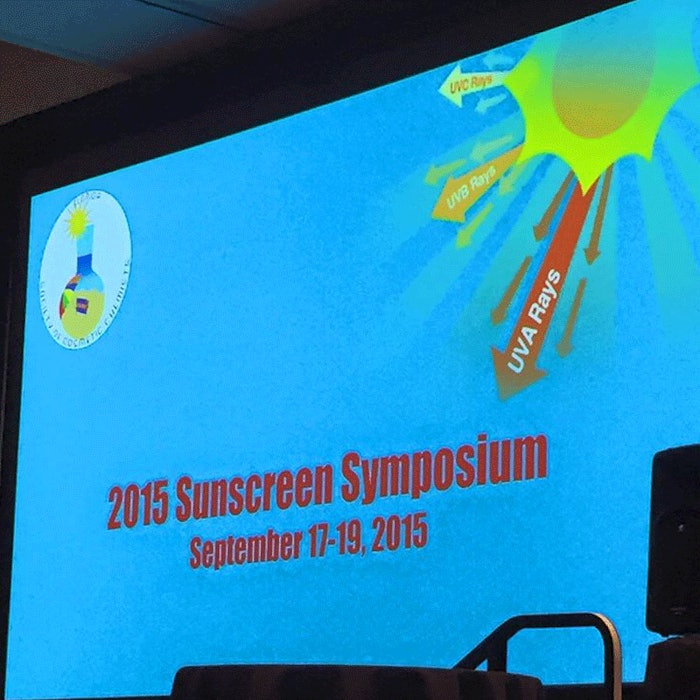
When you wish upon a star, sometimes science will come to you. That is exactly what happened Sept. 17-19, as cosmetic scientists from around the world descended on Walt Disney World for the 2015 Sunscreen Symposium, held at Disney’s Yacht Club Resort in Lake Buena Vista, Florida. Hosted by the Society of Cosmetic Chemists’ Florida Chapter, the two-day symposium featured 64 exhibitors and presentations from industry leaders on topics including skin safety, boosting sunscreen efficacy, testing, formulations and more.
UV Rays, Spin Coating and Regulations
The knowledge sharing kicked off with Estelle Loing, Ph.D., global R&D director, Lucas Meyer Cosmetics, who discussed a timeline about the evolution of discoveries about the sun’s effects and explained to attendees the significance of protecting skin from the sun and sun-induced aging. Some of the highlights include:
- 1801: Germans discovered UV rays,
- 1918: Sun linked to cancer and melanoma,
- 1936: Eugène Schueller launched the first sunscreen for only UVB rays,
- 1977: UVA exposure became evident to change skin,
- 1986: Photoaging linked to the sun,
- 2006: Visible light linked to skin damage and
- Today: Infrared, UVB, UVA and UVC are connected to skin damage.
Joseph W. Stanfield, president of Suncare Research Laboratories, LLC, followed with an introduction to spin coating, a new technology for sunscreen testing. Used in the silicone industry to produce films of uniform thicknesses, spin coating can be used to test sunscreen for more precise measurements of SPF. Sunscreen is applied to a rotating flat plate that is spun at high velocity, spreading it to a uniform thickness and facilitating non-invasive SPF determinations.
Next, Julian P. Hewitt, director, JPH SunCare Technologies Ltd., discussed new opportunities for global sunscreen formulations. Hewitt noted his aspiration for the U.S. Food and Drug Administration’s approval on eight UV filters and for EU to approve zinc oxide (ZnO) for more opportunities in sunscreen development. He also mentioned a few strategies to impact potential development in sunscreen formulations, which include:
- Organic only,
- TiO2: the simplest approach for globally approved formulation,
- TiO2 and ZnO: ideal for baby sunscreens due to the mildness of inorganics and
- Organic/inorganic combinations.
Ingredients, Formulations and Efficacy
Christine Mendrok-Edinger, senior application scientist, DSM, (Switzerland), brought awareness to the attendees on the science behind potassium cetyl phosphate (PCP). She gave insight on various findings of products, which can enhance versatility and stability of sunscreens.
Bart Maxon, senior industry specialist, Dow Corning Corporation, then transitioned to strategies for increased compliance of sunscreen use through reduced whitening. Maxon discussed formulation approaches reducing whitening on ethnic skin associated with applying sunscreen on wet skin and using sunscreen actives. He also showed illustrations supporting ethnic skin tones and efficiencies of sunscreens.
Next, Yun Shao, Ph.D. and vice president of R&D, Kobo Products, Inc., discussed some practical tools for boosting sunscreen efficacy. He showed the attendees formula and testing scores for sunscreens and also summarized:
- Both water dispersible and oil soluble film former is effective in boosting SPF,
- SPF/PFA can boost protection if combined and used properly and
- Antioxidants and bioactives hold UVA and UVB protection.
Regulations, Sensory Properties and UV Protection
Uli Osterwalder, senior marketing manager and scientific adviser in sun care, BASF, reviewed the next generation of sun care innovations and global regulatory requirements. He explained that the average person does not apply enough sunscreen to help protect them from the sun, despite the SPF level. Not all SPF 30 is created equal, he said.
Vincent Hubiche, personal care applications manager, Gattefossé SAS, then explained how climate can influence sensory properties of sunscreens. He believes that, to achieve the perfect topical agent, the consumer perception of sunscreen needs to be improved and that sunscreen should be added to daily products, both of which are challenges for the industry.
Wrapping up day one was John Sottery, Ph.D., and founder of IMS Inc., who gave insight on enhanced UVA and UVB protection. Sunscreens are body armor to block UV photons, and clothing is the best type of it against the sun, he said. Additionally, Sottery noted a trend that indicates those with less regular sun exposure have an increased chance of getting melanoma, due to their lack of natural vitamin D production.
Day one concluded with a gala event held at Fantasia Gardens and Fairways Miniature Golf, where attendees and speakers mingled to network and discuss their opinions.










